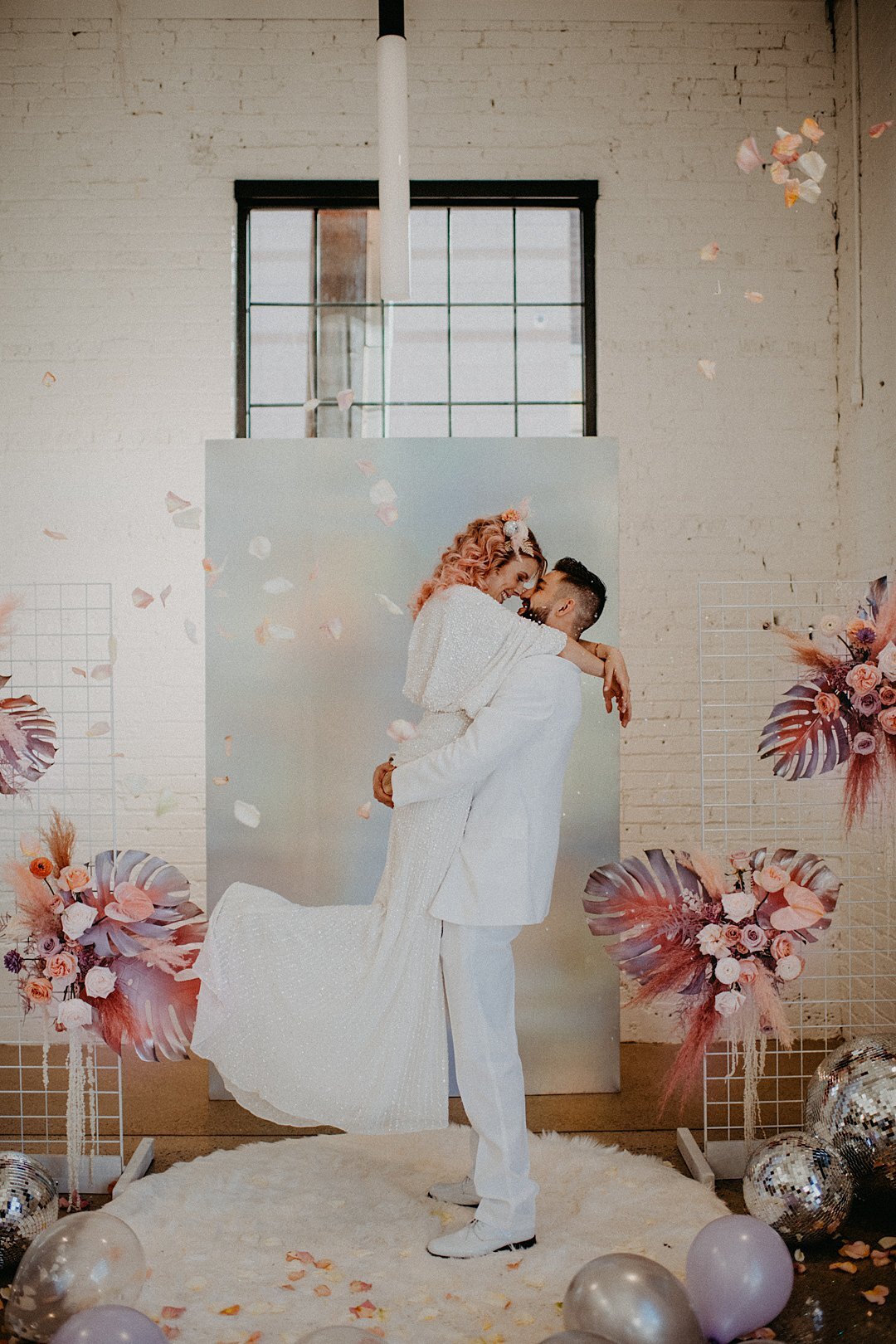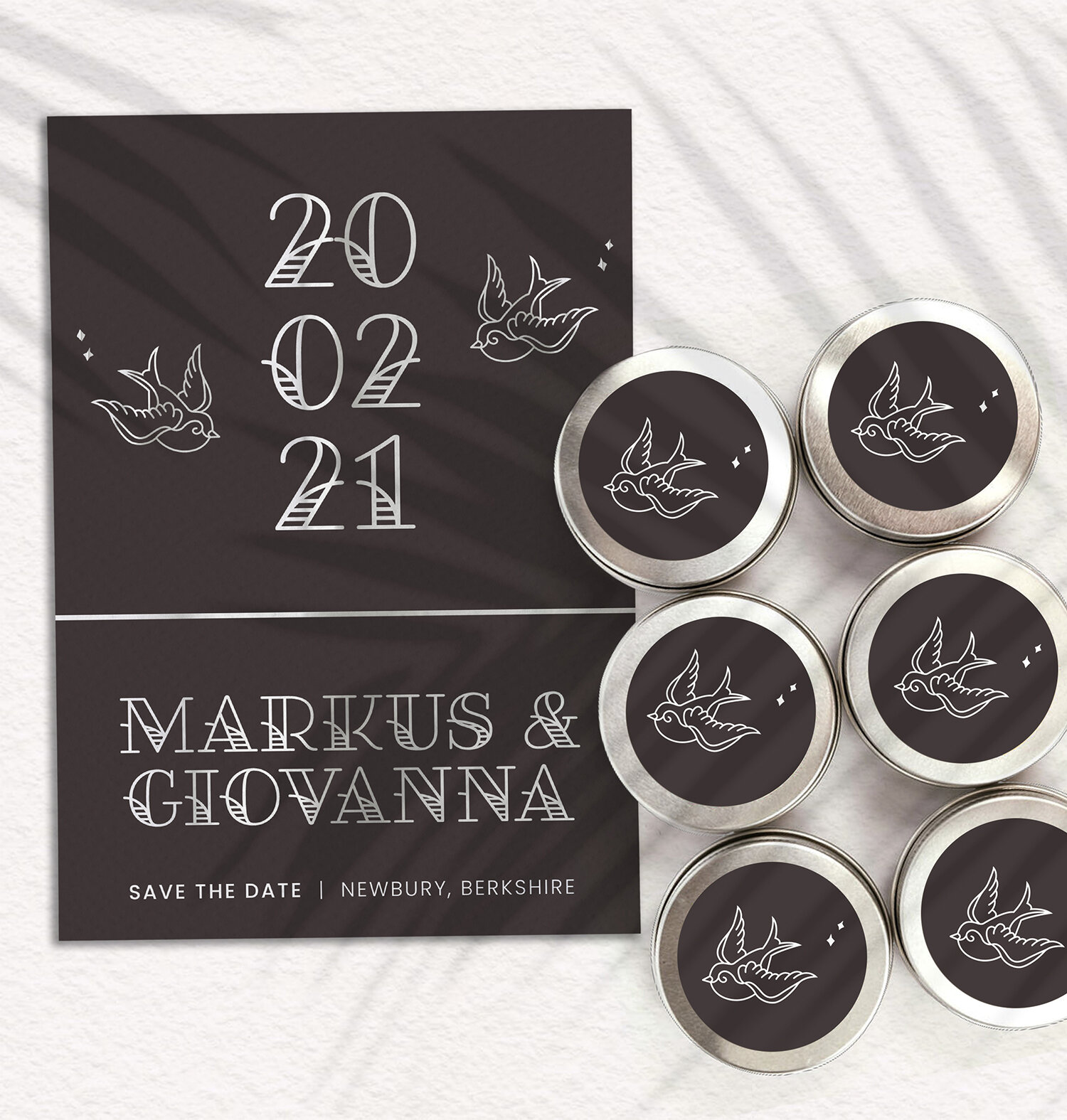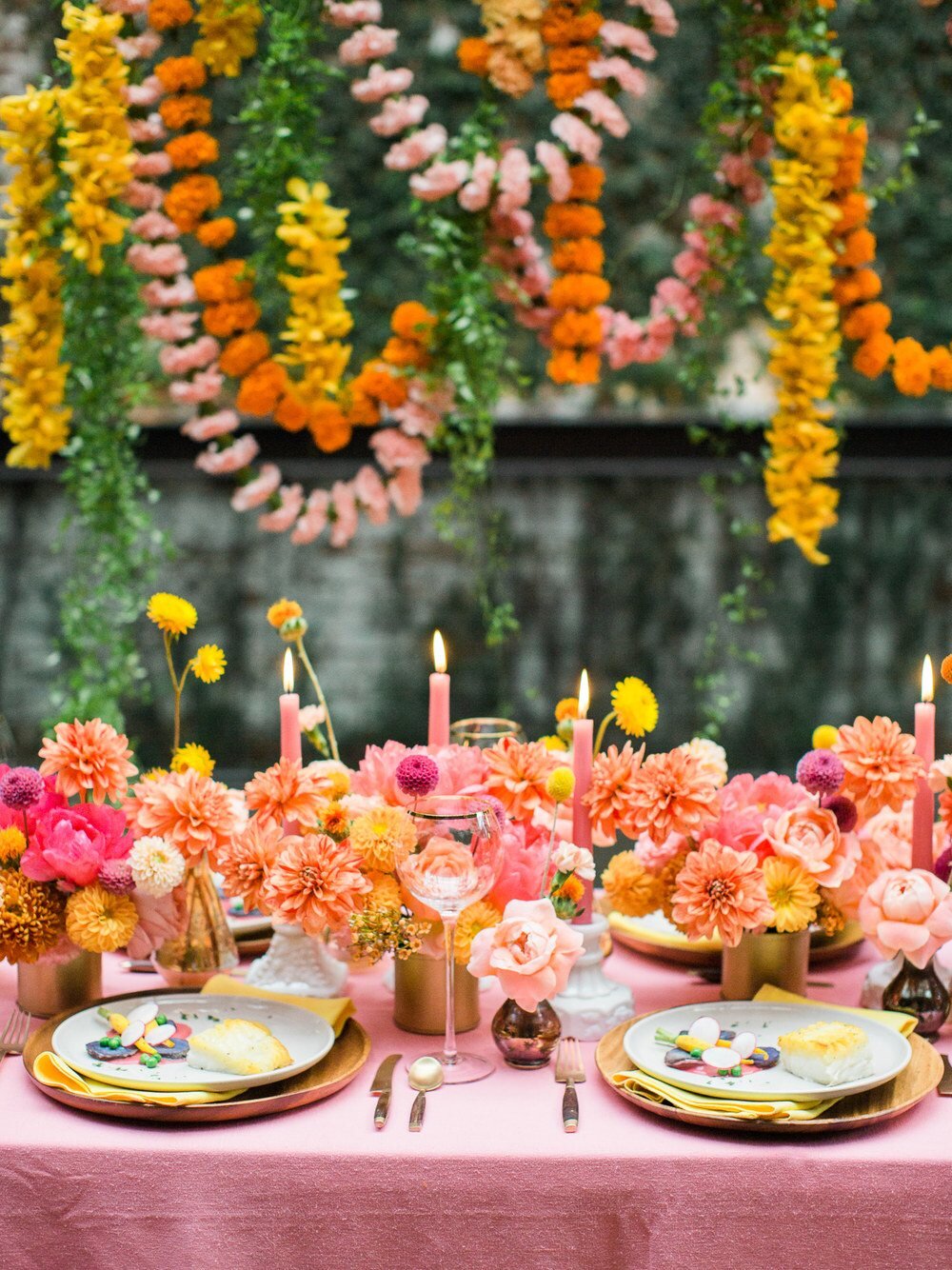A - Z of common wedding terms
Have you been planning your celebrations only to stumble across a phrase and think, “What the hell does THAT mean?! Do I need that?!”
Unless you work in the wedding industry or plan events professionally, you may not know your cummerbunds* from your corkage, and that’s okay. When I was engaged, I was CLUELESS and I found the wedding-planning lingo hard to follow.
Well, you can relax. This handy glossary of terms will fill in the gaps, so you can crack on with party-planning!
Altar
In days gone by, this exclusively meant the table at the front of a place of worship, and if you’re having a religious ceremony, this still stands. If you’re not, it means the place you stand during the ceremony where all your guests can see and hear you make your vows to each other.
The can be as simple or as over-the-top as you want!
via Festival Brides
Bouquet
A bunch of flowers, usually tied with string or ribbon. It’s common for a bride and a bridal party to have a bouquet each, but you can choose if you all have them, you dot them around the venue or not have them at all! They can be fresh, dried, artificial or made of paper or felt.
Photo by Jenny Markham
Image by Daze Photography & Film
Button holes
These are little bunches of flowers pinned to the lapel, or pushed through the button hole, of a suit jacket (or equivalent place on whatever you’re wearing!)
Image by Daze Photography & Film
via I Heart Buttons
Canapés
Yes please! These are little appetisers like a cracker topped with something tasty or a delicious small snack served on a spoon or a stick. Something you can pop in your mouth and enjoy in between all the mingling.
You tend to serve them once people arrive at the reception but before the main meal starts (see below: ‘Wedding breakfast’) to fill a hole and quite frankly keep people sober from all the merriment.
Carriages at midnight
It’s a very old-fashioned term, but basically it means ‘Please book transport home at midnight’ - or put more simply, this is when the party ends. It’s meant to be polite, but it’s so archaic that it confuses lots of people.
My advice is scrap the term, and simply pop something on your invitations something less formal, that feels friendly and more like you. For example, ‘We can’t wait to celebrate our day with you, all the way ‘til midnight!’ (or whenever your wedding celebrations end).
It’s usually determined by your venue, and it’s handy to let your guests know this on the invitations or wedding website as it allows them to plan ahead.
Celebrant
This is the person who leads your ceremony. They’re different to a registrar because they tailor your service to you (and you still need a registrar to actually make it official). An enthusiastic celebrant can make the difference between the plain exchange of ‘I do’s and a really meaningful, personal and engaging ceremony.
Centrepiece
These are something pretty to look at in the middle of your table. My advice would be to skip these on your actual dining table, or make them low-level or transparent as experience will attest that all they do is block your view of the people sat opposite you.
This can make things extra awkward if your guests have never met each other. If they’re trying to be polite, they’d be bobbing around trying to peek at each other and make chit-chat through the centrepiece, and who wants that?! Here’s a nice example:
Photo by Emilie May
However, if you were having a dessert table, you’d probably make a wedding cake the centrepiece. It’s basically the item you’d like the most attention to be given to amongst a collection of other things.
Corkage
This is a cost that a venue will charge you to open bottles of alcohol. This only happens if you have a dry hire wedding (see below). It’s important you ask about this and factor it in to your budget because it can be a sudden shock if you’re not aware of it!
Cake topper
A figurine of the two of you, a sign with your names on, a lego model of Hogwarts… (just me?!)…A cake topper is simply an object you place on top of a cake. Think of it as the wedding equivalent to birthday candles. It just says “I am a wedding cake”, but of course you don’t need one! It’s your choice.
via Nouba
Photo by Jessica Grace Photography
Day-of coordinator
These people are angels. They’re hyper-organised, high-energy folk (the kind that actually DO have clipboards) who make sure your day runs smoothly. They allow you to actually participate in your wedding, rather than just host. You work with them before the day so they know all the timings, the whats and wheres, and they work the whole day long to make it happen. Not a must-have, but highly recommended!
I really rate both Jump The Broom and Devine Bride for this job!
Destination wedding
Basically a holiday and a wedding rolled into one! A destination wedding is one that you have abroad. Sometimes the celebrations last a little longer and as well as the wedding day, the couple host a few days of get-togethers and activities.
Dry hire
A dry hire venue is one that allows you use of the blank canvas space, but doesn’t have in-house catering or a bar. In this circumstance, you need to find people to come in and make (and serve) food and drinks. Opting for this gives you more flexibility in terms of where you get married but there’s more organising to do, too. A wedding planner (see below) can really help with this, but of course you can do it yourselves.
Escort cards
I would do these if a couple requested them, but they’re less common than a table plan and place names (see below) because, in my opinion, they’re more confusing. They’re little cards laid on a welcome table that have the names and table number of each of your guests on, to show them where to sit.
The reason I prefer a table plan is because a guest can see their name on a list and sometimes the table plan even shows where that table is located. I’d argue finding your name in a sea of cards is harder!
They can be branded to match all of your other stationery.
Favours
These are little gifts you give your guests as a token of thanks for coming to your wedding, and often they’re placed on their spot at the table. Think candles, wildflower seeds, chocolates - just something small they enjoy on the day or take home with them.
I’ve collaborated with Grant + Blossom to make hand-poured candle favours which actually match the same style as your stationery, like invites and menus. You can check those out here.
Head table
This is the table where the brides, grooms and their families tend to sit. It’s common to have this table somewhere everyone else can view, so it’s easy for them to watch and listen to speeches, if you do them. Some people call it a ‘top table’.
Hen do (and Stag do)
This is a pre-wedding party to celebrate your engagement with your best mates and close family - a last hurrah of sorts. People tend to split it so all the people who identify as women (the Hens) have a separate party to their male counterparts, the Stags. Nowadays you do what you want, and mixing the groups is sometimes known as a Sten or Hag do.
If you ned help planning one of these, because you’re a bridesmaid, groomsman, Maid or Mate of Honour (see below), then I’ve put together some top tips just for you.
Master of Ceremonies
Also simply ‘The MC’, this is your friend or family member who is the loudest, most charismatic, and can herd all your guests through the milestones of your wedding. They often have a microphone, and at key points of the day, like when dinner is served, they let everyone know. It can really add some flare to your day if this person is warm, funny and likeable. Which I’m sure all of your mates are!
Mate of Honour (and Best Woman)
A Maid of Honour is someone who a bride picks to be their chief bridesmaid, and they identify as female. A Mate of Honour is the male equivalent. It’s a lovely title because if you’re a bride-to-be and your best friend or sibling isn’t female, they still get to be an official member of your wedding party.
A Best Man is chosen by a groom to do that same job for them, and is, as it says on the tin, someone who identifies as a man. A Best Woman is a groom’s main go-to who is female.
On the day stationery
I like to just call this ‘wedding day stationery’ because I think it’s more self-explanatory! These are order of service sheets or booklets, place names, table plans, escort cards, menus, welcome signs and anything else paper-based that you use to give your guests the information they need to navigate your day and venue. It’s ideal if they all match in terms of colours, fonts and styles so that your guests can easily recognise them.
Photo by Caroline Opacic
Open bar
Something your guests might love but your bank balance might not! An open bar means that your guests keep their purses and wallets closed and that you provide all the drinks for free. It’s very advisable that you tell the bar to cap it at a certain limit, for obvious reasons!
Alternatively, you could have certain drinks be free and others available to buy. Sometimes a couple brews their own beer or makes their favourite punch, but ask their guests to pay for cocktails, wine and spirits.
Order of service
This is a document, usually a booklet or sheet, which tells your guests what is happening on your wedding day, in order. It could be just for the ceremony or it could cover the whole day’s festivities.
It might contain details of a reading, like the title, who wrote it and who is giving it, or even the lyrics to a song or hymn if you’re hoping people sing!
Palette
This is just a fancy word for your colour scheme. It really sets the mood for the day - muted tones feel relaxed and bright hues with high contrast imply it’s time for a party! If you’re struggling to choose a style for your wedding, read this blog post.
Place names
These are little cards you place on each table setting, and each one has an individual guests’ name on it. It helps them to find their seats for the main meal (see Wedding breakfast).
Photo by Lex Fleming
RSVP
An acronym for the French ‘Répondez s'il vous plaît’, it simply means ‘kindly respond’. An RSVP card is a piece of stationery that allows your guests to tell you whether or not they can make your wedding. There’s often space for dietary requirements and occasionally a tickbox for them to say they’d like to stay at the same accommodation as the couple.
You can provide a stamp and envelope or they can use their own. You can also have a RSVP via email or text if you want to save on paper or need a quick response.
Save the date
Just like an RSVP, these are also a simple piece of card. You send them in advance of your main invitations, and they just ask your guests to hold that date in their diaries.
Sending these ahead of a main invitations allows you to secure a date and maximise your chances of everyone you want to come being available, without you having had to plan every detail of the day first.
Stationery suite
My numero uno, my true love - the stationery suite 🖤 This is all your matching paper bits that ask your guests to come to your wedding, tell them the details, help direct them on the day and thank them afterwards. Stationery suites can include:
Save the dates
Invitations
Information cards
Envelopes
RSVPs
Orders of service
Welcome signs
Table plans
Table names or numbers
Place names
Escort cards
Food menus
Cocktail menus
Thank you cards
Photo by Lex Fleming
Sweetheart table
This is a bit like a top table but it’s set for two. It’s an intimate set up for the couple, which in retrospect, I think we would have enjoyed at our wedding. We got married and then were so busy hosting, we didn’t really spend any time together until the next day!
Photo by Map + Compass
Having that moment to really take it all in would be special and give you that chance to take a breath before the party really kicks off.
Tablescape
This is the table in it’s entirety. It can look breath-taking when everything comes together. Breaking bread with your loved ones is so special, and a well thought-out tablescape can not only be an ice-breaker for guests meeting for the first time, but it’s a beautiful backdrop for all those little magic moments.
It’s where the guests eat, where they listen to, and toast to, your speeches about how much you love each other, and - if they’re so inclined, it’s usually where they start to get a bit merry!
Tablescapes can include:
Plates
Crockery
Cutlery
Glasses
Tablecloth or linens
Napkins
Centrepieces
Flowers
Candles
Menus
Place names
Table names/numbers
Favours
via Ruffled
Photo by Stephanie Green
Table plan
This is a big poster you put at the entrance to where people will eat. It has table names or numbers, each with a list of guests’ names and it shows them where to sit. Depending on your venue, most tables seat 8-12 guests each.
If you’re having a more relaxed day, perhaps with street food or a buffet, then you don’t need one of these as people will take a seat wherever suits them. If you do opt for more formal dining, often your venue can provide an easel to prop the poster up on - make sure to ask them before purchasing one yourself.
When we were planning our wedding, creating our table plan was a long ol’ task. We wanted everyone to feel comfortable, and we had to factor in accessibility issues, single guests who didn’t know anyone and those dreaded ex-couples who wanted to keep their distance!
If you have a table plan, it’s really useful to plot it out so at least one gregarious, welcoming person is sat on each table to get the conversations going! You can even plant ice-breakers on each table, like questions to ask each other, if you want to.
Usher
An usher is another word for a groomsman (but they can be male or female). They simply welcome your guests to your ceremony, help the elders find a seat and could be in charge of the ceremony music.
Wedding breakfast
This is the main meal on your wedding day. It’s called a breakfast to indicate it’s your first meal as a married couple, even though it’s most likely to be served in the late afternoon or evening. It’s a funny phrase and probably the most common confusing term in this whole list!
Photo by Bless Photography
Wedding party
All your favourite people! This is bridesmaids, groomsmen, both sets of parents and you, the couple.
Wedding planner
This might be the same angelic person who is running your on-the-day coordination. They help source suppliers, negotiate with the venue and take charge of all the wedding admin (or ‘wedmin’, if you like) so you can focus on being happily engaged.
These are particularly helpful if you’re having a big wedding or a destination wedding where you don’t speak the language, because a native speaker is a real asset to have on board. You can also find dry hire specialists who really know their stuff on blank canvas venues.
Wedding stylist
These are very creative people who can pull together backdrops, tablescapes, seating areas, flowers - you name it - to style your day consistently. A stylist can be the difference between a pretty wedding and a jaw-dropping one. Just hand them a moodboard and see what they can do!
Photo by Caroline Opacic of Zuza McKen - WholeLottaLove Weddings
*Cummerbunds
These are so uncommon, but just in case… It’s that crazy bit of material round the waist, as part of a suit. If you want ‘em, you do you!
via Cat Poland
If I’ve missed something and you want to ask me about it, then please get in touch. I’d love to help and hear about your plans!
Carly x
























